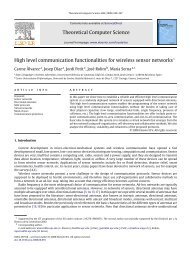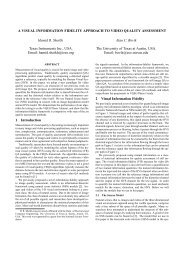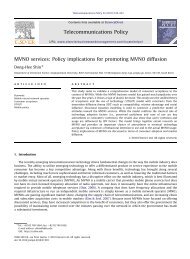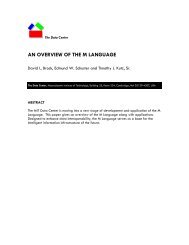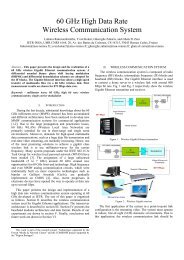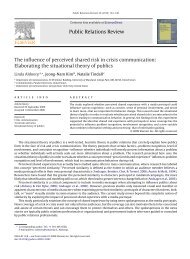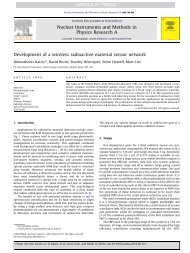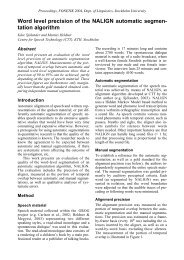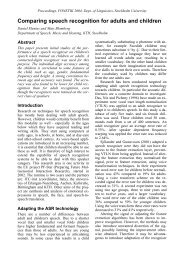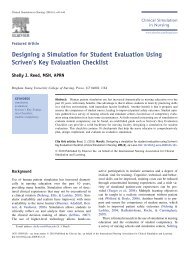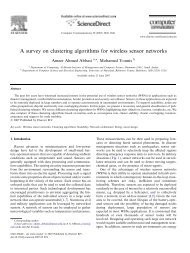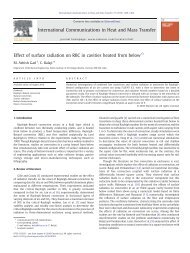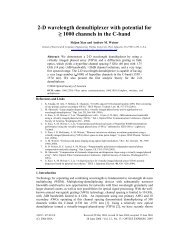BLR: beacon-less routing algorithm for mobile ad hoc networks
BLR: beacon-less routing algorithm for mobile ad hoc networks
BLR: beacon-less routing algorithm for mobile ad hoc networks
Create successful ePaper yourself
Turn your PDF publications into a flip-book with our unique Google optimized e-Paper software.
<strong>BLR</strong> <strong>for</strong> static <strong>networks</strong>, since data packets are delayed at<br />
each node in <strong>BLR</strong>. The <strong>ad</strong>vantage of <strong>BLR</strong> in terms of endto-end<br />
delay is that the per<strong>for</strong>mance is basically independent<br />
of the mobility. Packets are delivered after approximately<br />
30 ms even <strong>for</strong> high mobility in our simulations. It is<br />
worth noting that the end-to-end delay of <strong>BLR</strong> is even <strong>less</strong><br />
than the Max_Delay set to 40 ms <strong>for</strong> one hop. Due to the<br />
high node density, the probability is high that there is always<br />
a node with a large progress within the <strong>for</strong>warding area<br />
which computes a DFD much shorter than Max_Delay.<br />
6. Conclusion<br />
Conventional position-based <strong>routing</strong> protocol suffer from<br />
several drawbacks caused by the proactive bro<strong>ad</strong>casting of<br />
<strong>beacon</strong>-messages, such as outdated neighbor tables and<br />
control packet transmissions which degr<strong>ad</strong>e network<br />
per<strong>for</strong>mance. The <strong>BLR</strong> <strong>routing</strong> protocol described in this<br />
paper avoids any <strong>beacon</strong>ing mechanism, i.e. nodes do not<br />
need knowledge about their neighborhood. Packets are<br />
bro<strong>ad</strong>casted and the next hop is chosen in a completely<br />
distributed way by introducing a Dynamic Propagation<br />
Delay at each receiving node depending on its relative<br />
position in the <strong>for</strong>warding area. Some limitations and<br />
fundamental properties of <strong>BLR</strong> are derived, which demonstrate<br />
that network per<strong>for</strong>mance is highly dependent on node<br />
density and transmission range. In high node density<br />
<strong>networks</strong> or with large transmission ranges, <strong>BLR</strong> is capable<br />
of operating in greedy mode <strong>for</strong> a long time. However, since<br />
<strong>BLR</strong> operates on the actual topology and is completely<br />
state<strong>less</strong>, the per<strong>for</strong>mance is almost independent of node<br />
mobility. Analytical results are supported by simulations,<br />
which show a superior per<strong>for</strong>mance of <strong>BLR</strong> compared to<br />
GPSR and LAR1.<br />
7. Outlook<br />
In future works, we will extend the current implementation<br />
of the <strong>BLR</strong> protocol with options and variations<br />
discussed in this paper (backup mode, unicast packets,<br />
different <strong>for</strong>warding areas and delay functions, etc.) in order<br />
to investigate and demonstrate different scenarios such as<br />
low node density and high traffic volume. A further<br />
direction of research is the use of directional antennas.<br />
Directional antennas seem to be well suited <strong>for</strong> <strong>BLR</strong> since<br />
only a part of the actual transmission range is used to find a<br />
next hop, namely the <strong>for</strong>warding area. Currently, 802.11<br />
DCF is the most widely used MAC-protocol <strong>for</strong> <strong>ad</strong> <strong>hoc</strong><br />
<strong>networks</strong>. The overhe<strong>ad</strong> introduced with the RTS-CTS-<br />
DATA-ACK dialog renders several <strong>ad</strong>vantages provided by<br />
<strong>BLR</strong> use<strong>less</strong>. There<strong>for</strong>e, we plan to investigate MACprotocols<br />
<strong>ad</strong>apted to our <strong>routing</strong> protocol. Multiple access<br />
schemes (e.g. CDMA) could be exploited to increase the<br />
per<strong>for</strong>mance and capacity of the network.<br />
M. Heissenbüttel et al. / Computer Communications 27 (2004) 1076–1086 1085<br />
Acknowledgements<br />
We would like to thank Hans U. Schmid <strong>for</strong> his valuable<br />
comments and review of the paper. The work presented in<br />
this paper was supported (in part) by the National<br />
Competence Center in Research on Mobile In<strong>for</strong>mation<br />
and Communication Systems (NCCR-MICS), a center<br />
supported by the Swiss National Science Foundation<br />
under grant number 5005-67322.<br />
References<br />
[1] Mobile <strong>ad</strong>-<strong>hoc</strong> <strong>networks</strong> (manet) Working Group, Internet Engineering<br />
Task Force, September 2003, [Online]. Available: http://www.<br />
ietf.org/html.charters/manet-charter.html<br />
[2] C.E. Perkins, E. Royer, Ad-<strong>hoc</strong> on-demand distance vector <strong>routing</strong>,<br />
in: Proceedings of WMCSA ’99, New Orleans, USA, February 1999,<br />
pp. 90–100.<br />
[3] D.B. Johnson, D.A. Maltz, J. Broch, DSR: the dynamic source <strong>routing</strong><br />
protocol <strong>for</strong> multihop wire<strong>less</strong> <strong>ad</strong> <strong>hoc</strong> <strong>networks</strong>, Ad Hoc Networking,<br />
Addison-Wesley, Re<strong>ad</strong>ing, MA, 2001, ch. 5, pp. 139–172.<br />
[4] V.D. Park, M.S. Corson, A highly <strong>ad</strong>aptive distributed <strong>routing</strong><br />
<strong>algorithm</strong> <strong>for</strong> <strong>mobile</strong> wire<strong>less</strong> <strong>networks</strong>, in: Proceedings of INFO-<br />
COM ’97, Kobe, Japan, April 1997, pp. 1405–1413.<br />
[5] C. Perkins, P. Bhagwat, Highly dynamic destination-sequenced<br />
distance-vector <strong>routing</strong> (DSDV) <strong>for</strong> <strong>mobile</strong> computers, in: Proceedings<br />
of ACM/SIGCOMM ’94 Conference on Communications<br />
Architecture, Protocols and Applications, London, UK, August<br />
1994, pp. 234–244.<br />
[6] B. Bellur, R.G. Ogier, A reliable, efficient topology bro<strong>ad</strong>cast protocol<br />
<strong>for</strong> dynamic <strong>networks</strong>, in: Proceedings of INFOCOM ’99, New York,<br />
USA, March 1999, pp. 178–186.<br />
[7] T. Clausen, P. Jacquet, P. Muhlethaler, A. Laouiti, A. Qayyum, L.<br />
Viennot, Optimized link state <strong>routing</strong> protocol, in: Proceedings of<br />
INMIC ’01, Lahore, Pakistan, December 2001.<br />
[8] Z.J. Haas, M.R. Pearlman, A hybrid framework <strong>for</strong> <strong>routing</strong> in <strong>ad</strong> <strong>hoc</strong><br />
<strong>networks</strong>, in: Ad Hoc Networking, Addison-Wesley, 2002, pp. 221–<br />
253.<br />
[9] A. Iwata, C.-C. Chiang, G. Pei, M. Gerla, T. wei Chen, Scalable<br />
<strong>routing</strong> strategies <strong>for</strong> <strong>ad</strong> <strong>hoc</strong> wire<strong>less</strong> <strong>networks</strong>, IEEE J. Select. Areas<br />
Commun. 17 (8) (1999) 1369–1379.<br />
[10] G. Pei, M. Gerla, T.-W. Chen, Fisheye state <strong>routing</strong> in <strong>mobile</strong> <strong>ad</strong> <strong>hoc</strong><br />
<strong>networks</strong>, in Proceedings of ICDCS ’00, Taipei, Taiwan, April 2000,<br />
pp. 71–78.<br />
[11] P. Bose, P. Morin, I. Stojmenovic, J. Urrutia, Routing with guaranteed<br />
delivery in <strong>ad</strong> <strong>hoc</strong> wire<strong>less</strong> <strong>networks</strong>, ACM/Baltzer Wire<strong>less</strong><br />
Networks 7 (6) (2001) 609–616.<br />
[12] B. Karp, H.T. Kung, GPSR: Greedy perimeter state<strong>less</strong> <strong>routing</strong> <strong>for</strong><br />
wire<strong>less</strong> <strong>networks</strong>, in: Proceedings of MOBICOM ’00, Boston, USA,<br />
August 2000, pp. 243–254.<br />
[13] Y.-B. Ko, N.H. Vaidya, Location-aided <strong>routing</strong> (LAR) in <strong>mobile</strong> <strong>ad</strong><br />
<strong>hoc</strong> <strong>networks</strong>, ACM/Baltzer Wire<strong>less</strong> Networks 6 (4) (2000)<br />
307–321.<br />
[14] L. Blazevic, S. Giordano, J.-Y. Le Boudec, Self organized terminode<br />
<strong>routing</strong>, Cluster Comput. J. 5 (2) (2002) 205–218.<br />
[15] F. Kuhn, R. Wattenhofer, A. Zollinger, Asymptotically optimal<br />
geometric <strong>mobile</strong> <strong>ad</strong>-<strong>hoc</strong> <strong>routing</strong>, in: Proceedings of DIALM ’02,<br />
Atlanta, USA, September 2002, pp. 24–33.<br />
[16] M. Grossglauser, M. Vetterli, Locating nodes with ease: mobility<br />
diffusion of last encounters in <strong>ad</strong> <strong>hoc</strong> <strong>networks</strong>, in: Proceedings<br />
INFOCOM ’03, San Francisco, USA, March 2003.


